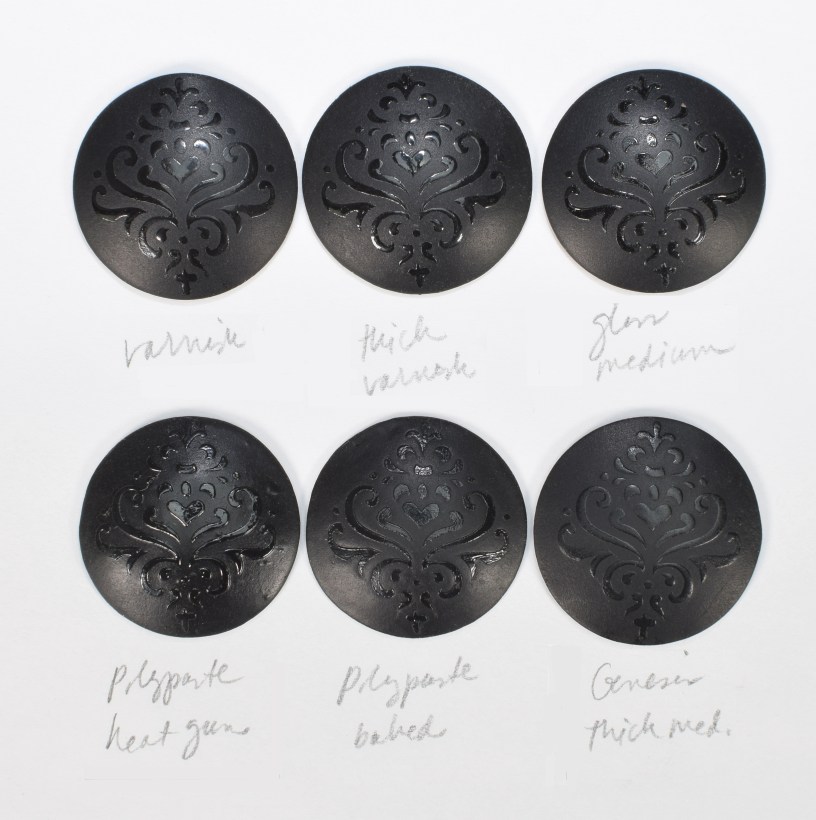It’s not as easy as you’d think to create a raised, shiny design the same color as the clay. I tried several products:
- Kato Liquid Clay
- Cernit Glue
- Fimo Liquid Gel
- Ultradome UV Resin
- Genesis Glazing Gel
- Genesis Thick Medium
- Kato Poly Paste
- Cernit Gloss Varnish
- Cernit Gloss Varnish with a tiny bit of Liquitex thickening gel
- Golden Gloss Medium
I would have tried Clear Liquid Sculpey, but mine has separated into a hard layer at the bottom and liquid on top. I can’t easily mix it back together. I’m now storing my liquid clay on its side and rolling it occasionally to keep it mixed.
Below is my first test of liquid clays: Kato Liquid Clay, Cernit Glue and Fimo Liquid Gel.

I learned they need to go on thick to remain glossy. Also, Kato needs a higher baking temperature than I normally use with Cernit clay or it stays white in the center. I re-baked the example above at 300˚F and used a heat gun on it. Cernit Glue was glossy after it cooled, but became dull when I touched it.
I decided Fimo Liquid Gel gave the best result at a lower temperature, so I tried applying it with a brass stencil. The liquid clay collected around the edges of the stencil and thinned out in the center. With repeated tries, I could not get a consistently smooth surface. Then I tried a different stencil that I cut out of Siser heat-transfer vinyl. It’s paper thin and doesn’t have the problem with liquid clay collecting around the edges. The Fimo Liquid Gel looked like it would be raised and glossy, but when I baked it, the gloss disappeared, maybe because it wasn’t thick enough. See the photo below.

I then tested Ultradome UV Resin, Genesis Glazing Gel and Genesis Thick Medium. I learned that Ultradome UV resin doesn’t totally cure on raw clay. The top will cure, but the bottom which is in direct contact with the clay remains wet. When I baked it, Ultradome UV Resin got a crinkled outline around it. In the photo below, the resin is on the left and Genesis Thick Medium is on the right.

Genesis Glazing Gel is thin, behaves like liquid clay and didn’t work well. However, Genesis Thick Medium domed up and worked like a charm. It sets up after a couple of hours so the clay can be manipulated before baking. It has more of a satin finish instead of glossy.
Still not getting the glossy finish I wanted, I tried Cernit Gloss Varnish, Cernit Gloss Varnish with a bit of Liquitex Thickening Gel, Golden Gloss Medium and Kato Poly Paste.
Plain Cernit Gloss Varnish was very shiny. Thickening it up makes it dome, which gives a nice effect. Golden Gloss Medium and Kato Poly Paste weren’t as smooth and domed as the others, even when Poly Paste was heated with a heat gun.

In the photo below is another example of Kato Poly Paste before and after using the heat gun. Kato Poly Paste is in the center. The left is Cernit Gloss Varnish with a tiny bit of Liquitex Thickening Gel added. The right disc is Genesis Thick Medium. These seemed like my best candidates.

With Kato Poly Paste, the shine depends upon how hot it’s cured. If it’s baked lower than 300˚F, it doesn’t fully cure and stays matte or whitish. If it’s baked at 300˚F, it gets somewhat shiny. If you use a heat gun, it gets really shiny. The problem with the heat gun is that you have to have skills to use it that I don’t have yet. I watch carefully, but it doesn’t seem to go glossy until the background clay also goes glossy, develops bubbles and sends out a wisp of smoke. If it were white clay, I’d probably see it turning brown.
The funny thing is, the satin finish of the Genesis makes the design easier to see because there’s less reflection.
Another thing I tried in the photo above was making the clay more matte by burnishing a piece of paper on the surface. This works well and increases the contrast between glossy and matte.
In conclusion, the two I thought gave the best smooth, domed finish were:
Cernit Gloss Varnish with a tiny bit of Liquitex thickening gel for a glossy look
Genesis Thick Medium for a satin look


I was reading on a site where people make new born baby dolls using genesis paints and glazes. They said when they like a wet look on it, they use acrylic glaze diluted with a little water. I think they just then allow it to dry, no heat involved. Hope it helps
LikeLike
Thanks, Paula!
LikeLike
Where did you get this beautiful dome? Thank you
LikeLike
If you mean the damask design, I cut it out of stencil material with my Cricut machine.
LikeLike